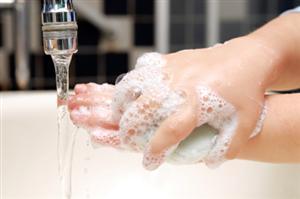| Complexity level: | 6 |
| Project cost ($): | 10 |
| Time required: | 1 day to prepare, 5 days for experiment |
| Material availability: | Easily found |
| Safety concerns: | The bacteria should be destroyed before disposal. Pour some bleach into the petri dishes to kill all the bacteria before disposing. |
Hypothesis
Anti bacterial soap will kill more bacteria than normal soap.
Overview
Antibacterial soap
Antibacterial soap contains certain chemicals such as triclosan, which helps kill bacteria. However these chemicals are effective at targeting only some types of bacteria. Since there are many types of bacteria, a particular antibacterial soap may not be effective in killing all forms of harmful bacteria which we come into contact with.
There is growing concern that the overuse of antibacterial soap will cause bacteria to evolve and become immune to the ingredients used in antibacterial soap. Another concern of overuse is that the use of antibacterial soap reduces our own immunity to bacteria because our bodies have not been exposed to bacteria.
In addition, it is interesting that many websites and publications state that it is sufficient to wash our hands and bodies with warm water and ordinary soap to prevent infection.
Scientific Terms
Materials
The materials required for the experiment:
- 4 petri dishes with blood agar
- Some human saliva
- 4 disposable chopsticks
- 1 ruler
- Antibacterial soap
- Non-antibacterial soap
- 1 Stopwatch
- 1 disposable cup
- 1 permanent marker pen
Procedure
- For this experiment, the independent variable is the type of soap and the length of time taken to wash. The dependent variable is the rate of growth of the bacteria colony. This is determined by measuring the size of bacteria colony growth. The constants (control variables) are the room temperature, the amount of sunlight and the preparation of the petri dish blood agar.
- The petri dish prepared with the blood agar must be stored in a refrigerator. Before the start of the experiment, take the blood agar-filled petri dish out of the refrigerator and leave it out under room temperature conditions.
- Collect some saliva in a disposable cup.
- Mark the chopsticks A, B, C and D. Dip all 4 chopsticks into the saliva. For each of the chopsticks, do the followingChopstick A ?the saliva is left on the chopstick
- Chopstick B ?the chopstick is washed with non antibacterial soap for 2 minutes
- Chopstick C ?the chopstick is washed with antibacterial soap for 20 seconds
- Chopstick D ?the chopstick is washed with antibacterial soap for 2 minutes
- Mark the Petri dishes as A, B, C and D. Remove the cover and let the tip of each corresponding chopstick touch the center of the respective petri dishes. Replace the covers and store the petri dishes in a cool place, away from direct sunlight
- Measure the diameter of the bacteria colony growth everyday for 5 days and record the results in the table below.
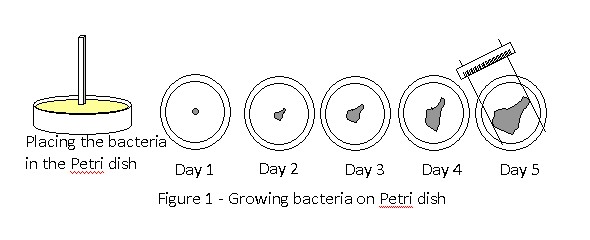
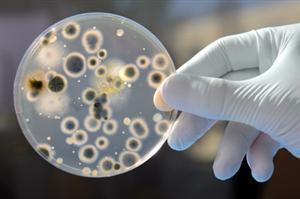
Results
The results show that the antibacterial soap is only effective in killing all the bacteria if the chopstick was washed for more than 2 minutes. If it was washed with antibacterial soap for less than 2 minutes, it was only effective in killing some of the bacteria. Though the non-antibacterial soap also kills the bacteria, it was not as effective as the antibacterial soap.
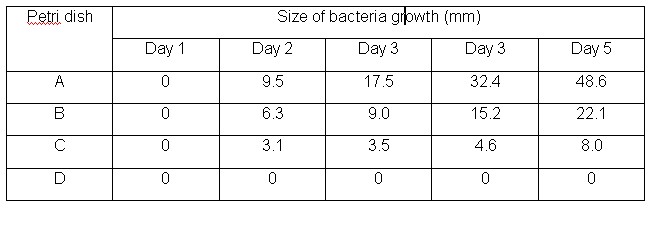
Use the graph below to plot the results from the table above.
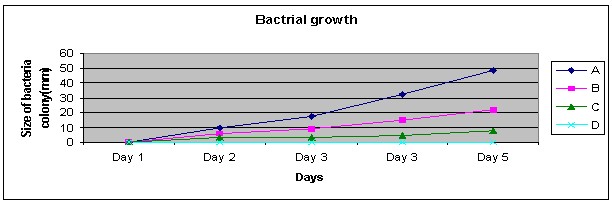
Conclusion
The hypothesis that antibacterial soap will kill more bacteria than normal soap is proven to be true. However the antibacterial soap was effective only if the contaminated object (chopstick) was washed with antibacterial soap for more than 2 minutes.
Many diseases, such as influenza, are caused by viruses and not bacteria. These diseases are not prevented by the use of antibacterial soaps. Washing our hands with warm water and regular soap is sufficient to ward of infections provided that we thoroughly wash our hands, soaping them properly.
Also consider
The experiment can be repeated by touching the petri plate with a finger instead of using saliva.
Try to repeat the experiment under different room temperatures and/or lighting conditions to ascertain if there is any impact on the rate of growth of the bacteria colonies.
Also consider repeating the experiment with anti-bacterial sprays/hand-rubs.
References
- Antibacterial soap - http://en.wikipedia.org/wiki/Antibacterial_soap
- Is antibacterial soap any better than regular soap? - http://health.howstuffworks.com/skin-care/cleansing/myths/question692.htm

